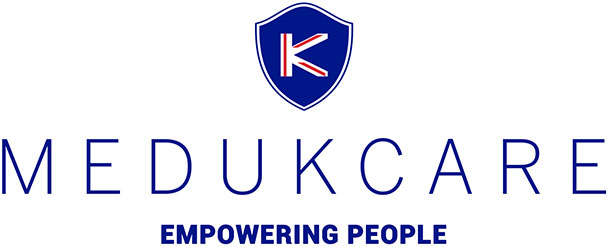Please be advised that these are GENERAL suggestions. Be sure to seek out a formal clinical swallowing evaluation with a registered speech therapist trained in dysphagia management (dysphagia = swallowing disorder).
PREPARING FOR A MEAL
If possible reduce auditory/visual distractions during mealtimes (i.e. loud radios, TV, noisy visitors etc.) You want as much focus as possible on the task of eating/swallowing safely.
Ensure your loved one is sitting as upright as possible for the meal (ideally in a chair).
However if bed-bound make sure they are propped up as high as possible. Most important is that the chin is tucked slightly down towards the chest. This reduces the risk of food/liquid prematurely spilling back into the throat. Placing a small rolled towel behind the neck to gently prop the head/neck forward and slightly down can help.
Make sure all sensory aids are in place (glasses, hearing aids etc.). If worn, dentures should be freshly cleaned and secured well in the mouth. If dentures are mod-extremely ill fitting – best to leave them out and downgrade to a smoother texture until they are properly refitted.
SELF FEEDING AND ASSISTED FEEDING
Present only one or two food items at a time. Many items at once can be cognitively overwhelming.
If within their ability, continue to encourage the person with dementia to feed themselves, but monitor to ensure small bites/sips taken. If independent self feeding becomes difficult, a gentle hand-over hand tactic works wonders.
The brain will get a BETTER signal if the person with dementia is in any way involved in feeding themselves. Your own hand coming towards your mouth is a long-ingrained pattern that tells the brain (open your mouth, food is coming, prepare to chew… swallow! etc.).
Being fed by someone can feel invasive and often causes people to “clam up” and “refuse”. If you are getting this response, try the hand-over-hand method along with gentle verbal cues – “John, we’re having a spoon of yogurt now..”, “this is a bite of chicken”. I’ve seen this work WONDERS over the years!
FOOD TEXTURE MODIFICATIONS
There are many different stages of food texture modification that are possible. If “regular/unmodified” food is challenging, try downgrading meals to “casserole soft” or “fork mashable”.The important thing is that the food is soft/moist and more “cohesive” i.e. it sticks together. Usually the most difficult solids to manage are ones that are: fibrous (ie. celery, pineapple) or granular/particulate/flaky (dry seeds/nuts, granola, dry rice, crumbly biscuits/crackers).
Eventually you may get to the point where pureed foods are necessary, but again your SLT can let you know if/when that is necessary.
Another sneaky culprit to watch out for are the TWO TEXTURED or MIXED TEXTURED foods. These are foods that have both a liquid and a solid component together (i.e. chicken noodle soup, dry cereal with milk, fruit cocktail with syrup, even a really juicy piece of watermelon). The reason these are so difficult is that the mouth has to manage TWO different things at once: chewing and keeping the solid bits in a formed bolus whilst trying to control the liquid portion from prematurely falling back into the throat . This is a highly cognitive task that is beyond many people in the moderate to later stages of dementia.
So what can you do? You can either avoid these items altogether (i.e. choose broth or cream soups, drain the liquid from the fruit cocktail etc.) OR if you have a very diligent caregiver who is assisting with feeding you can ALTERNATE liquid bites and solid bites. For example when eating chicken noodle soup, the first spoonful would be just the broth and the next one would be just the noodle/veg bits with the liquid drained off the spoon.
LIQUIDS
Let’s talk about liquids. It CAN get to the point where thickening liquids with commercial thickening agents are necessary for safety reasons however I would not start doing this unless advised by an SLT. Why? Because they don’t taste good! They don’t feel natural. People tend to take less of them and then run the risk of dehydration. If you’re noticing some difficulty with liquids here are some things to try first:
If sips of liquid are not going well. Try offering them on a teaspoon. A smaller volume can sometimes solve the problem.
Ensure you are offering liquids only when the mouth is completely clear of food. Again, this may seem counter-intuitive. Most people would think to offer a sip of liquid to help get the food down right? Well.. think back to the TWO TEXTURED FOOD problem. We are trying to avoid having liquids and solids in the mouth at the same time. It’s better to encourage clearing their mouth of food, then offer a small sip of fluid.
If they need something moist to help clear a dry item, offer instead a spoon of applesauce or yogurt – these have a natural thickness that will be easier to control in the mouth.
Try offering “naturally” thicker items with meals like smoothies, tomato juice or chocolate milk.
As a last resort, keep thin liquids separate from food. Offer them in between meals on their own (not with any food). The rationale for this is that if a bit of liquid is going to go down the wrong pipe (this is called “aspiration”) at least it won’t take a piece of food with it into the lungs.
ORAL CARE
One of THE MOST IMPORTANT habits to implement is DILIGENT ORAL CARE. This is the most protective thing you can do to prevent aspiration type pneumonias.
Did you know that the real culprit for these types of pneumonias is NOT the food or liquid entering the lungs? The food and liquid are merely the vehicles for the MOUTH BACTERIA to enter the lungs and colonize.
Remember A CLEANER MOUTH = CLEANER LUNGS. You cannot do enough oral care. Especially just before a meal and just after.
For further information please contact: MedUKCare




